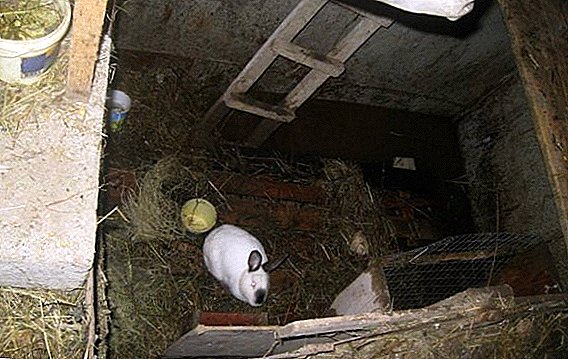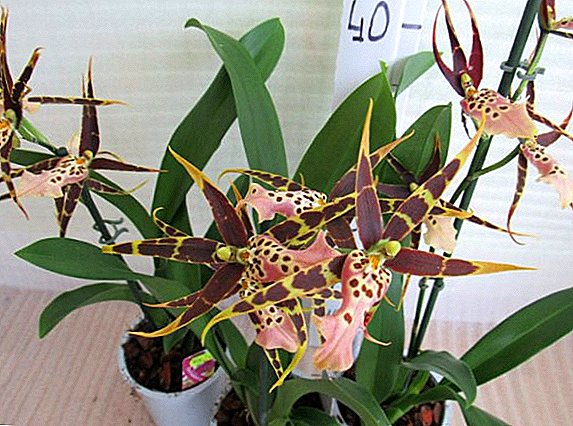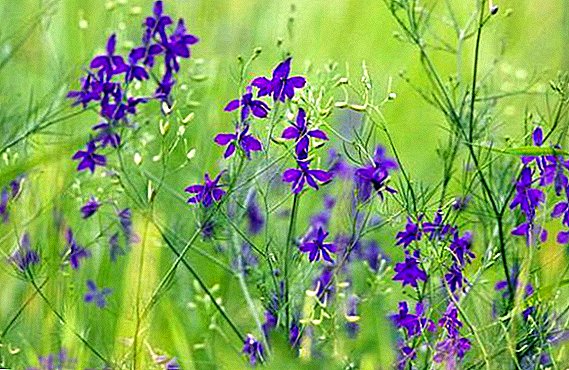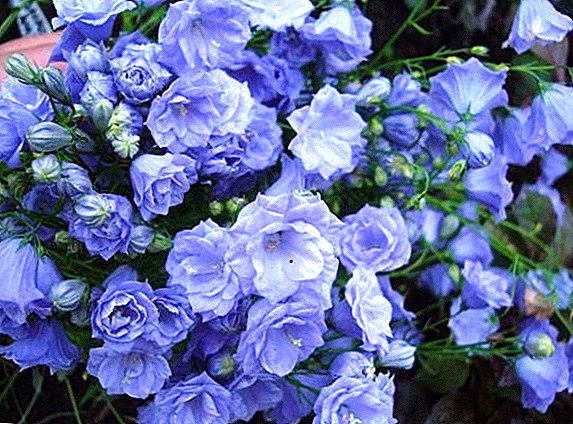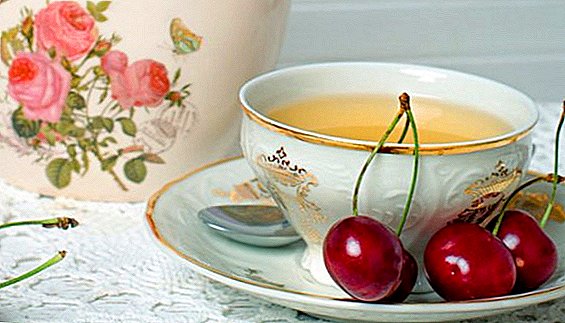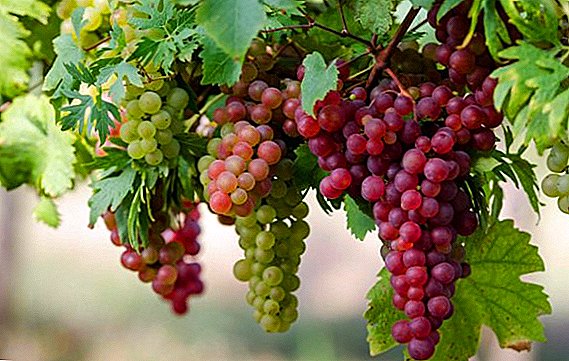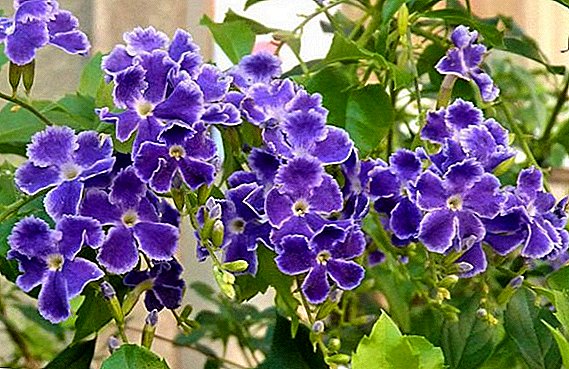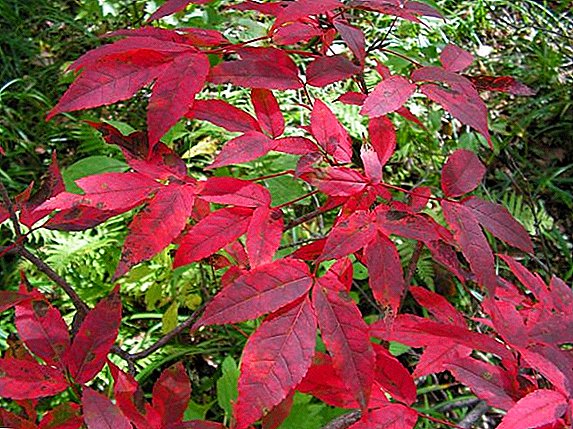 Manchurian maple is a very slim and beautiful tree with leaves of rather unusual shape. And although his homeland is the Far East, he has long been fond of gardeners and gardeners from different parts of the world. In addition to its decorative, this maple has one more property: it is a wonderful honey plant. How to grow this tree yourself - read our article.
Manchurian maple is a very slim and beautiful tree with leaves of rather unusual shape. And although his homeland is the Far East, he has long been fond of gardeners and gardeners from different parts of the world. In addition to its decorative, this maple has one more property: it is a wonderful honey plant. How to grow this tree yourself - read our article.
Botanical description
Manchurian maple reaches a height of about 20 m, the diameter of its trunk - up to 60 cm. The bark is gray or brownish-gray.
Familiarize yourself with the most popular maple species: Red, Norway, Tatar, Japanese, and Alpine (American).The leaves are trifoliate complex with long reddish petioles. They are lanceolate, ovate-lanceolate, oblong-ellipsoidal, up to 8 cm in length and 2.5 cm in width.

Yellow-green flowers are connected in shields of 3-5 pieces. Fruits - bare lion of 3-3.5 cm. The tree blossoms in May, and bears fruit in September.
Did you know? In the old days, the spinning wheels were mainly made from maple, since the strength and uniform structure of the tree made it possible to make a comb with thin and long teeth. These ridges can still be seen in museums and old huts.
Spread
The main habitats of Manchu maple are: Primorsky Krai, North Korea, Northeast China. It is found in mixed and deciduous forests, mainly in river valleys.
But today it can also be found in gardens and arboreta far from home, for example, in Boston (USA) or Hamilton (Canada). 
Growing at home
Now let's understand how to plant maple at home.
Breeding
One of the methods of reproduction of the Manchu maple is by seeds:
- Buy seeds or collect them near autumn maple trees.
- Next is the seed stratification process. Put them in a small container with wet sand and save 100 days in the refrigerator or cellar (temperature is from + 3 ° C to -3 ° C).
- In the middle of spring, plant the seeds in an open ground for germination, but before that during the day, keep them in hydrogen peroxide. Choose a place where there will be enough sun. The soil should be loose and fertilized.
- Plant seeds to a depth of no more than 4 cm, keeping to a distance of 1.5 m between plantings.
- Liberally pour and constantly maintain the humidity of the earth in the near future.
- The first shoots will appear after 15-20 days. Before the cold, seedlings grow to about 40 cm.
- The entire warm season constantly water the plants and gently weed from the weeds.
 Manchurian maple seeds
Manchurian maple seedsThere is another, simpler way of such reproduction: on the eve of winter, plant seeds in open ground, and they will germinate in spring.
Important! Saplings from seeds in the first year of their life can grow up to 80 cm. After 3 years they can be transplanted to a permanent place.
You can apply the method of grafting, which is held in late summer or early autumn:
- Prepare cuttings about 25 cm long. Lower the cut at an angle.
- On the prepared for rooting shoot, leave 2 leaves, which shorten by half.
- Before planting, maintain cuttings in a growth stimulant solution for 24 hours.
- Drop them into the ground to a depth of 5 cm. The soil is light and wet. The most suitable substrate will be from earth, peat and sand (proportion: 3: 2: 1).
- In the spring, transplant the cuttings into a fresh substrate.
 Planting cutting Manchurian maple
Planting cutting Manchurian mapleAnother breeding option - air layouts:
- In early spring, on a young branch with a clean knife, make several oblique cuts through the bark, treat them with a root formation stimulator.
- In order to avoid accretion of cuts, insert there on a piece of foam or on a clean pebble, then wrap it with wet moss-sphagnum and seal it with polyethylene.
- To avoid overheating, wrap it all up with a foil or a soft cloth on top.
- For the season, the branch will give roots right into the moss. The next spring, unwind everything, cut off the layers and put him in a permanent place.
Read how to grow a home maple (abutilon).The same method rooted and offsprings that grow from the base of the tree. But they do not impose a "compress" from the moss, but tilt to the ground and drop the section with cuts (until the next spring).
 Manchurian Maple Breeding by Air Layers
Manchurian Maple Breeding by Air LayersFor such a decorative maple, you can also use the grafting method to cross 2 different varieties. True, he is only by experienced gardeners. So:
- At the beginning of spring, cut off the maple cuttings and store them in peat moss slightly moist at 0 ° C until the leaves on the plant rootstock are dismissed.
- As soon as the growing tree has a rich selection of juice, make a thin cut on the stock in the place where there is a kidney. As a rule, it is at a height of 1.5-3 m, but it is allowed and immediately above the root collar - a crown-ball will be left lying on the ground.
- Cut off exactly such a bud with a scute from the graft cutting. Carefully, without touching your fingers, put it on the knife to the tree-rootstock and attach to the slice, so that at least one edge coincides. Secure with bandaging tape without covering the kidney.
- To make the graft turn into a spherical crown, cut all the branches from the rootstock below the grafting site, as well as the top of the plant, leaving only 2-3 branches above the graft to feed the plant.
- Last native branches need to be removed when the graft takes root and begins to grow.

Important! Do not forget to cover all sections with a garden pitch.
Landing features
Maple trees are planted, usually in spring or autumn, it all depends on the breeding method.
Maple Manchu needs a spacious and well-lit place. A small shadow, he will also be able to transfer, but only a small one. With more shading, the tree may begin to grow more slowly, and it is likely that the color of the leaves will change. Thus, he can lose all his decorativeness.
For trees that will grow alone, leave a distance of at least 3 m from each other. And 1.5-2 m is enough for a hedge.
Dig a hole 50 × 50 × 70 cm in size (length, width, depth), pour drainage there — small pebbles, broken bricks, crushed stone. Add any mineral fertilizer to the pit. Sapling (before planting, hold it a little in the water to feed the roots), carefully place it in the center and sprinkle around the trunk with a mixture of humus, sand and leafy earth.  Planting a maple Put a small peg near a sapling and tie a trunk to it, this will save the immature plant from strong wind. Also, do not forget to form a watering hole next to the seedling.
Planting a maple Put a small peg near a sapling and tie a trunk to it, this will save the immature plant from strong wind. Also, do not forget to form a watering hole next to the seedling.
If you plant a hedge - the procedure will be the same, but only in this case you will need a long trench of about the same depth and width as the pit.  We tie the trunk to the young maple
We tie the trunk to the young maple
Soil and fertilizer
Maples like fertile land with a slightly acidic or at least neutral reaction. If your site is clay soil, it must be dug up and mixed with sand and peat. If on the contrary, dry peaty, then digging it, add sand and clay.
Due to its rich composition, maple is endowed with a whole range of healing properties. Read about the use of maple in traditional medicine.If you have not applied mineral fertilizer during planting, then next spring add 40 g of urea, 15-25 g of potassium salts, 30-50 g of superphosphate per 1 m². In summer, when loosening and watering, Kemir Universal is usually added - 100 g per 1 m².
In general, maple fertilizing with fertilizers is necessary 1 time per year, and organic matter (manure, bird droppings) is used 1 time in 4 years. 
Watering and moisture
Maple trees do not like swampy soils, so they need poor and infrequent watering. It is necessary to water a sapling more abundantly only in the first year so that the plant is well rooted.
An adult tree is enough to be watered once a month, in extreme heat you can 3-4 times. On 1 tree you need about 10 liters of water.
Loosening and mulching
Loosening is required irregularly, usually when weeding or after watering, so that soil does not become compacted.
If you want to protect the plant from possible natural troubles, find out why you need soil mulching, especially the reception of agrotechnical reception.After planting, tree trunks mulch with peat or ground with a layer of 3-5 cm. In the summer, in order to keep the roots dry, the maple can be mulched using a shell of nuts or sawdust. Such a mulch will retain moisture and protect the plant from weeds.
 Maple trunk mulching
Maple trunk mulchingPruning
From a tree, dry and diseased branches should be removed from time to time. Cutting it is not necessary. But if you still want to make the maple crown more decorative and cut your hair, you will have to do this all the time - otherwise the crown will grow too thick, and the trunk with branches may not withstand such a weight.
To improve the maple and direct its growth in the right direction, find out all the features of pruning in spring, autumn and summer.So once a year, namely in winter, you will need to remove dry, frozen, sore branches, after which - weak and improperly located, and at the end - align the shape of the crown.
Important! Remember: the shorter you cut the tree, the thicker it will become its crown.

Preparing for the winter
Maple Manchu winter-hardy. Additional winter shelter is necessary only for young seedlings - if there is not enough snow, their root neck is covered with spruce leaves or dry leaves.
But the trunks of young maple in the first 2-3 years of their life should be warmed with sacking, wrapping it in 2 layers.  Manchurian maple shelter for the winter
Manchurian maple shelter for the winter
Pests and diseases
Maple can be subject to such troubles:
- Coral spotting (burgundy spots on the bark, the dying off of some branches): the affected branches must be removed immediately, cuts are well covered with garden pitch, and the cutting tool must be disinfected. In addition, it is recommended to carry out the prevention of this disease: 3 times every 5 days to carry out the eradicating treatment with copper sulphate on dormant buds (5%).
- Mealy dew (tar spots on the leaves): you can pollinate a tree with ground sulfur and lime in a ratio of 2: 1. As a preventive measure, copper sulfate will also be good.
- Maple whitefly: spraying is carried out on the larvae with 0.1% "Aktellik" or ammophos, in June it is treated with chlorophos (0.15%). In addition, it is necessary to collect and burn dry leaves.
- A maple mealybug: before blooming the kidneys, it is possible to carry out prophylaxis - spray the tree with Nitrafen (3%). In the summer (end of June - beginning of July) it is possible to process Carbofos (0.1%).
- Maple leaf weevil: tree treated with chlorophos (0.3%). Conducted also priming the soil in the projection of the crown of the plant, using granular chlorophos (7%).
- Aphids: maple is sprayed with insecticide for sucking pests, for example, dimetoatom.

Features leaf fall near the tree
In September - the beginning of October (it all depends on the temperature and humidity of the air - the warmer and drier it is on the street, the later the leaf fall begins) the maple leaves become purple in color, after which the leaf fall immediately begins. The tree enters a state of rest.
The end of leaf fall is usually accompanied by a strong cooling, frequent rains and large gusts of wind. Maple trees most often laid bare around October 20. Only single leaves are kept on the branches until mid-November. 
Did you know? In Russia in the XIX century there was such a tradition: a small child was passed between maple branches. This tree was considered the carrier of magical power, part of which was transferred to the child, and thanks to such a ritual a good and long life was waiting for him.
Manchurian maple will be the perfect decor for your garden or suburban area. The main thing is to plant it correctly and not to forget to take care of the tree. Although, as you already understood, it will not bring you any serious troubles. And if you read our article and read all the recommendations, then you definitely have nothing to fear.
Feedback from users on the effectiveness of the drug "Actellic"



